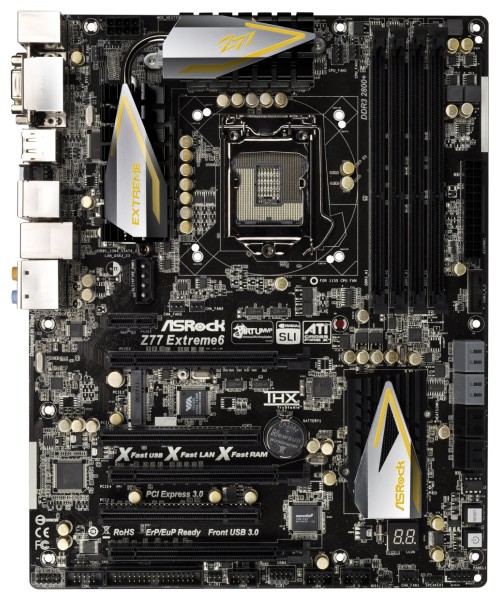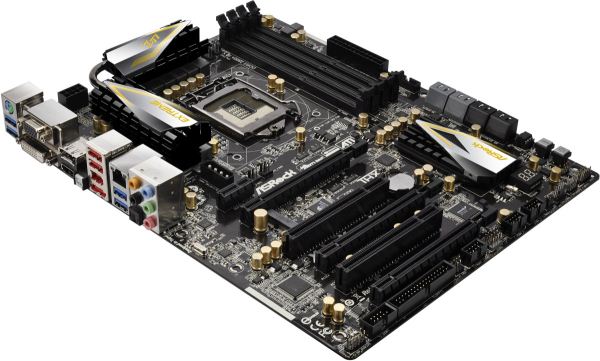Intel Z77 Panther Point Chipset and Motherboard Preview – ASRock, ASUS, Gigabyte, MSI, ECS and Biostar
by Ian Cutress on April 8, 2012 12:00 AM EST- Posted in
- Motherboards
- Intel
- Biostar
- MSI
- Gigabyte
- ASRock
- Asus
- Ivy Bridge
- ECS
- Z77
ASRock Z77 Extreme6—Visual Inspection
With the Extreme6, compared to the Extreme4, there are a significant number of changes, both visual and in terms of features. For a start, the heatsink design is more pronounced, using something similar to their X79 range in terms of black and gold ridged and edged surfaces. The VRM heatsink design is more substantial than the Extreme4, even though online it states it is still only an 8 + 4 VRM design—actually looking at the board, it seems more of a 10 + 4 design.
By looking at the motherboard, you would assume that it would support three-GPU setups. Unfortunately, this third full-length PCIe lane is only PCIe 2.0 x4, rather than splitting up the PCIe 3.0 lanes x8/x4/x4 or using a PLX chip. The MSRP for this board should be around $177, indicating that perhaps that is too cheap a board for one of the expensive PCIe 3.0 expansion PLX chips.

Onboard is also an mSATA port, right in the middle between the first PCIe slot and the PCI slot. Above the PCIe slots is a 4-pin molex power connector to provide extra power to the PCIe slots, although I am kind of getting tired of seeing it put in this location. If anything, it should be at the bottom end or beside the 24-pin power connector, as having it above the PCIe slots just means that there will be cables all over the place.
One other less obvious change to the Extreme4 is that there is a Floppy drive header on board. Yes, you heard me right—floppy drive! It seems odd now to include this legacy connection. It still has a place in industrial concepts (where a machine uses floppy drives and costs 1000x more than the PC processing its data), but not particularly on a higher end product which may be geared towards gaming and overclocking. Perhaps if ASRock are the only ones, then it creates a niche just for them.
In terms of fan headers on board, we have one three-pin beside the 8-pin 12V power connector, two CPU headers (one 4-pin, one 3-pin) just to the right of the top heatsink, two chassis three-pin headers beside the molex connector, and another 4-pin chassis header on the bottom of the board. On the right hand side, the USB 3.0 connector has been placed beneath the 24-pin ATX power connector, followed by the SATA ports. Like the Extreme4, we have the PCH SATA ports (two SATA 6 Gbps and four SATA 3 Gbps) and two extra SATA 6 Gbps from an ASMedia ASM1061 controller.
Around the larger chipset heatsink, we have power/reset buttons and a two digit debug display, both of which I personally like to see as a reviewer (makes my job a bit easier) but also helps overclockers. On the south side of the board, apart from that floppy connector I mentioned, we have a COM port, front panel audio, and an array of USB 2.0 headers.
PCIe layout is similar to the Extreme6, with a PCIe x1, PCIe 3.0 x16/x8, an mSATA connector, PCI, PCIe 3.0 x8, PCI, and a PCI 2.0 x4. This allows a user to use a dual GPU setup, and still have access to a PCIe x1 and x4.

Aside from the bowed picture from ASRock, we have something similar to the Extreme4 for the IO back panel, though this time with a DisplayPort output. From left to right, we have a combination PS/2 port, two USB 3.0 ports (blue), a D-Sub port, DVI-D, DisplayPort, HDMI, a ClearCMOS button, two USB 2.0 (red), an IEEE1394 port, eSATA, gigabit Ethernet, two more USB 3.0 (blue), and audio outputs including an optical SPDIF.
Board Features
| ASRock Z77 Extreme6 | |
| Size | ATX |
| CPU Interface | LGA-1155 |
| Chipset | Intel Z77 |
| Power Delivery | 8 + 4 |
| Memory Slots |
Four DDR3 DIMM slots supporting up to 32 GB Up to Dual Channel, 1066-2800 MHz |
| Video Outputs | DisplayPort, HDMI 1.4a, DVI-D, D-Sub |
| Onboard LAN | Broadcom BCM57781 |
| Onboard Audio | Realtek ALC898 |
| Expansion Slots |
2 x PCIe x16 Gen3 (x16, x8/8) 1 x PCIe x16 Gen2 (x4) 1 x PCIe x1 Gen2 2 x PCI 1 x mini PCIe |
| Onboard SATA/RAID |
2 x SATA 6 Gbps (PCH), Support for RAID 0, 1, 5, 10 2 x SATA 6 Gbps (ASMedia ASM1061) 4 x SATA 3 Gbps (PCH), Support for RAID 0, 1, 5, 10 |
| USB |
Two USB 3.0 at rear (PCH) Two USB 3.0 at rear (Etron EJ168A) One USB 3.0 header (PCH) |
| Onboard |
4 x SATA 6 Gbps 4 x SATA 3 Gbps 1 x Floppy Connector 1 x IR Header 1 x CIR Header 1 x COM Header 1 x SPDIF Header 1 x 4-pin Molex power connector Power/Reset Buttons Two Digit Debug LED 6 x Fan Headers Front panel audio connector 3 x USB 2.0 headers (support 6 USB 2.0 ports) 1 x USB 3.0 header (supports 2 USB 3.0 ports) |
| Power Connectors |
1 x 24-pin ATX connector 1 x 8-pin 12V connector 1 x 4-pin Molex for PCIe |
| Fan Headers |
2 x CPU Fan Header (one 4-pin, one 3-pin) 3 x CHA Fan Headers (one 4-pin, two 3-pin) 1 x SYS Fan Header (one 3-pin) |
| IO Panel |
1 x Combo PS/2 Port 1 x DisplayPort 1 x HDMI 1.4a 1 x DVI-D 1 x D-Sub 1 x Optical SPDIF 2 x USB 2.0 4 x USB 3.0 1 x IEEE1394 1 x Gigabit Ethernet 1 x Clear CMOS Audio Outputs |
| Warranty Period | 3 years from date of purchase |
| Product Page | Link |
Nothing immediately jumps out from the board features list aside from the differences to the Extreme4. This is a quite good package for an MSRP of $171.











145 Comments
View All Comments
ASUSTechMKT - Monday, April 9, 2012 - link
ASMedia does not produce or design a bluetooth controller. Additionally you are correct in that add in controllers do offer support for specialized modes of operation.functionality ( like charging )ASUSTechMKT - Monday, April 9, 2012 - link
the Intel controller under Windows 7 does not offer operating in UASP mode. With UASP the ASMedia add in controller can provide superior performance especially in queue depth. The USB3 Boost package is offered for both the Intel controller and the ASMedia ( Intel support change from BOT mode to SCSI ( Turbo mode ) and the ASMedia controller of support for BOT, SCSI ( Turbo ) as well UASP.MrMaestro - Sunday, April 8, 2012 - link
I didn't know a motherboard could be kitsch until I saw the ECS.XSCounter - Sunday, April 8, 2012 - link
P8Z77-M is the one I am waiting for for my Micro ATX build. It has no those xtra useless controllers which are all gonna be inferior to native Intel ones. So won't overpaying anything.However, I am planning to overclock so I wish to know how it will perform in this regard! Hoping to see these ASUS Micro ATX boards on Anandtech asap :)
http://uk.asus.com/Motherboards/Intel_Socket_1155/...
ASUSTechMKT - Monday, April 9, 2012 - link
It features a Digi+ VRM with robust VRM components overall in our testing the -M Pro provide comparable scaling to that of our standard board. You will see this information from ASUS soon. Solid board !Lonyo - Sunday, April 8, 2012 - link
What happened to the boards with 10 SATA ports?There were some from tradeshows earlier in the year, but none listed here (apart from the one with 8 + 2 eSATA).
Obviously this isn't a comprehensive lineup, but most of these seem to be fairly high end boards, yet no 10 SATA ports.
ASUSTechMKT - Monday, April 9, 2012 - link
Very few users use this many ports it makes sense more to prioritize expansion lane support to add ons that will be used. Keep in mind even with a board with that number of ports you may not actually be able to have that usable bandwidth.Should you really need that many you should consider an add on controller card. Things like SATA ports while important are not the only way to distinguish true attention to design in higher end boards.
aranyagag - Sunday, April 8, 2012 - link
"four SATA 6 Gbps also from the PCH," shouldn't that be sata 3 gbpsin the msi gd65 board
ConVuzius - Sunday, April 8, 2012 - link
The article says Virtu MVP has an i-Mode and a d-Mode, but which one is the better one? I kinda didnt get the difference, except where you connect your display.Ryan Smith - Sunday, April 8, 2012 - link
For regular Virtu, d-Mode is the mode that was better from a performance perspective, since at times performance under i-Mode dipped due to having to send frames out to the iGPU.For MVP, there's not going to be all that much of a difference. Regardless of the mode used Virtual V-Sync needs frames passed from the dGPU to the iGPU. The only difference is which display output is used, since a copy of the frame is on both GPUs (i.e. while you have to send frames to the iGPU, you don't have to send them back even in d-Mode).